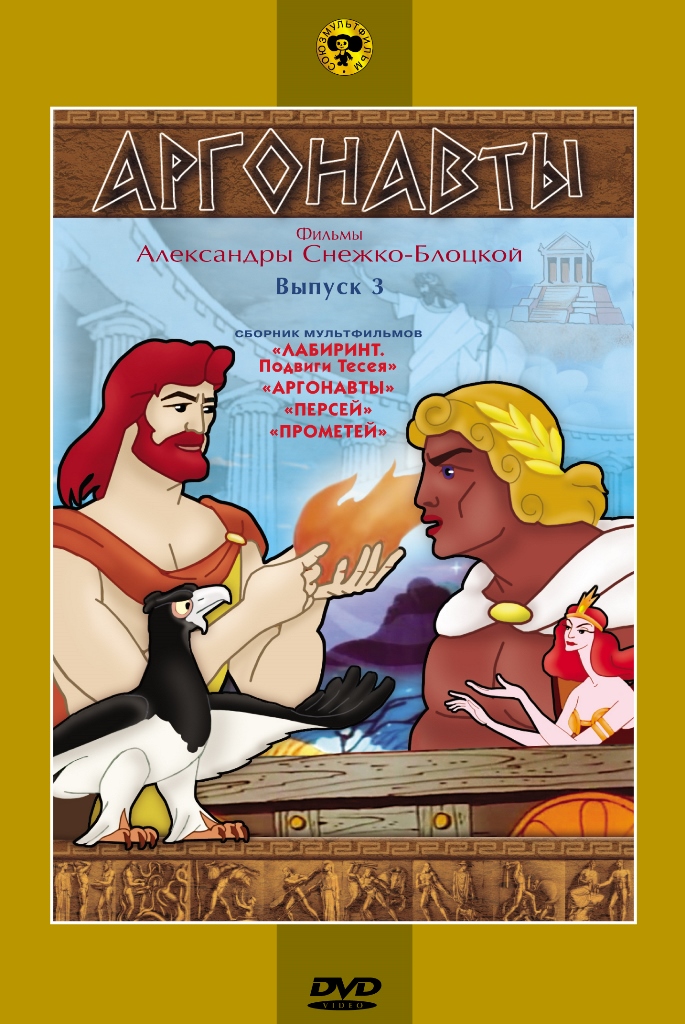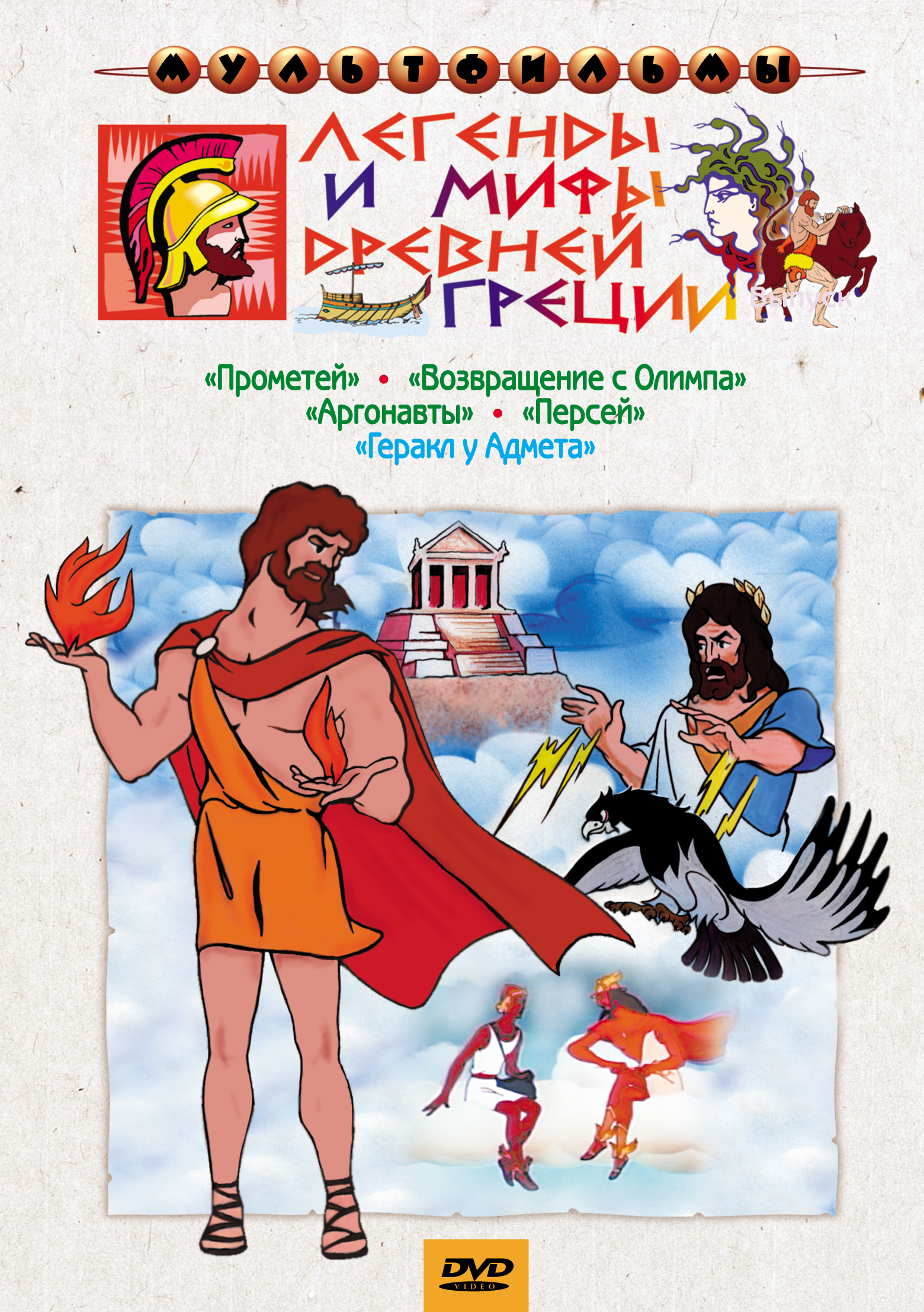Title of the work
Studio / Production Company
Country of the First Edition
Country/countries of popularity
Original Language
First Edition Date
First Edition Details
Аргонавты [The Argonauts (Argonavty)]. Directed by Aleksandra Snezhko-Blotskaia, script by Aleksei Simukov. Legends and Myths of Ancient Greece 3. Moscow: Soyuzmultfilm, 1971.
Running time
Date of the First DVD or VHS
Available Onllne
The movie is available on YouTube (accessed: February 21, 2019).
Genre
Animated films
Hand-drawn animation (traditional animation)*
Myths
Short films
Target Audience
Crossover
Cover


The covers of the entire series Legends and Myths of Ancient Greece. Courtesy of the Film Video Association “Крупный план” (Close-up, accessed: August 17, 2018).
Author of the Entry:
Hanna Paulouskaya, University of Warsaw, hannapa@al.uw.edu.pl
Peer-reviewer of the Entry:
Elżbieta Olechowska, University of Warsaw, elzbieta.olechowska@gmail.com
Susan Deacy, University of Roehampton, s.deacy@roehampton.ac.uk

Aleksei Simukov
, 1904 - 1995
(Screenwriter, Scriptwriter)
Aleksei Simukov was born in St Petersburg, in a family belonging to the intelligentsia. He received classical education at the Third Classical Gymnasium (the only one in St Petersburg where Greek and Latin was taught at the time). In 1925 Aleksei Simukov moved to Moscow. He studied at the art studio of Ilya Mashkov at the Association of the Artists of Revolutionary Russia (AKhRR) and also at the Maxim Gorky Literature Institute.
He began writing plays for theatre and cinema, including animation. He preferred comical and lyrical genres, following the tradition of the 19th-century Russian theatre.
Aleksei Simukov was a lecturer at the Maxim Gorky Literature Institute. He was a literary editor of the Soyuzmultfilm studio (1944–1946), worked at the Ministry of cinematography of the USSR (1947–1950), later at the Union of Soviet Writers (1950s), and still later at the Theatre Department of the Ministry of Culture of the USSR (1964–1971) having influence on the repertory of the theaters in the country.
In his memoirs Simukov writes about scripts for the movies of Aleksandra Snezhko-Blotskaia about the Greek mythology. He says that at that time he became fascinated by myths. They inspired him to continue developing this theme and he also wrote two plays about the Greek mythology. These were Гори, гори ясно (Burn, Burn, Brightly) about Heracles and Prometheus, and Взгляд Медузы (A Glance of Medusa) about Perseus.
His life spanned pre-revolutionary and post-Soviet Russia; he finished his memoirs in 1994, a year before he died.
Source:
Simukov, Aleksei, Чертов мост, или Моя жизнь как пылинка Истории [A Devil's Bridge or My Life as a Speck of History], Moskva: Agraf, 2008.
Bio prepared by Hanna Paulouskaya, University of Warsaw, hannapa@al.uw.edu.pl

Aleksandra Snezhko-Blotskaia
, 1909 - 1980
(Director)
Aleksandra Snezhko-Blotskaia was a Russian animator and movie director.
Born in Vovchansk in Kharkiv Oblast (today in Ukraine), she later moved to Moscow oblast and Moscow. In 1925–26 she studied at the Fëdor Rerberg Art School. In 1926 she joined an art studio at the Association of the Artists of Revolutionary Russia (AKhRR). She also studied at the Architecture and Construction Institute.
From 1934 she worked at animation. First, at the Союзкинотехника ([Soviet] Union Cinema Techniques), then at the Experimental Cartoon Studio directed by Victor Fëdorovich Smirnov, at the Межрабпомфильм (Movies for Workers International Relief). She started as animator, then for a long time worked as assistant-director for Ivan Ivanov-Vano. From 1956 she worked independently and produced film adaptations of fairy tales of different nations: Verlioka (a Russian folktale, 1957), Янтарный замок ([An Amber Castle], a Lithuanian folktale, 1959), Дракон ([A Dragon], a Burmese folktale, 1960–61), Чудесный сад ([A Miraculous Garden], a Kazakh folktale, 1962), Дочь солнца ([The Sun’s Daughter], a Chukchi folktale, 1964).
She also adapted Rikki-Tikki-Tavi (1965) and The Cat that Walked by Himself (1968) by Rudyard Kipling as well as Сказка о золотом петушке ([The Tale of the Golden Cockerel], 1967) by Alexander Pushkin.
In 1969–74 she produced a series of movies about Greek mythology commissioned by the Ministry of Education of the USSR: Возвращение с Олимпа (The Return from Olympus, 1969), Лабиринт – подвиги Тесея (Labyrinth, the Deeds of Theseus, 1970–71), Argonauts (1972), Perseus (1973), Prometheus (1974). It was the most important series of animated movies about Greek mythology ever made in the USSR. The Return from Olympus was the first movie in the series Legends and Myths of Ancient Greece.
Source:
Bogdanova, Siuzanna, “Очерки и жизни и творчестве Александры Гавриловны Снежко-Блоцкой” [Essays on the Life and Work of Aleksandra Gavrilovna Snezhko-Blotskaia], Кинограф 19 (2008): 207–240.
Bio prepared by Hanna Paulouskaya, University of Warsaw, hannapa@al.uw.edu.pl
Summary
Two Greek boys playing on the seashore notice a wrecked ship and an old man sitting nearby. The man, Jason, tells them the story of the ship (“Argo”) and recalls some of his friends the Argonauts (Theseus, the Dioscuri, the Boreads, Orpheus, and Heracles). He tells how the ship was built and how they journeyed to Colchis in order to find the golden fleece. Among the adventures Jason recalls moving rocks of Symplegades, Stymphalian birds, and sirens.
In Colchis in order to win the golden fleece Jason has to put a yoke upon fire-breathing oxen, to plow the field of Ares, and to sow the field with the dragon’s teeth. With the help of Medea he performs all the tasks. Aeëtes, a Caucasian king, lets Jason take the golden fleece, protected by a dragon. Medea helps the young man once again; he gets the fleece and takes Medea with him as well. On the way home, chased by Aeëtes, the Argonauts look for help from Poseidon. They arrive in Athens safe and give the fleece to the sanctuary of Athena. Here Jason’s story ends. The boys dream of becoming sailors and repairing the ship, and Jason prays to Zeus to thank him that the “Argo” will come back to life. During his prayer, the old man falls into a hole in the deck and dies. The boys continue his prayer.
Analysis
This is the third movie about Greek and Roman mythology produced for the audience of the entire Soviet Union. It uses the same theme as the first Soviet movie based on Greek mythology – Colchis directed by Vladimir Mujiri in Georgia in 1936. However the public had a limited access to the movie.
The myth of the golden fleece was chosen probably because it related geographically to Soviet territory – the Republic of Georgia – making Greek mythology in a way their “own” mythology.
Despite the simplicity of the narration, a few more complex issues are raised in the movie, for example, the adult perception of youth. The elderly Jason remembers the adventures of his youth with nostalgia. At the end of his story, answering the children’s eternal question “What happened next?” he answers: “For Jason there was no more ‘next’.”
The quest for the fleece is interpreted as a journey of young men looking for adventures (“merry fresh wind, waves […] and feats”). The boys listening to the story long to become real men like the Argonauts when they grow up. Young adulthood is understood as the “golden age” by the old man and by the children.
In my opinion, the Argonauts are presented not as super-heroes, but as ordinary men, who have their goal and do everything to achieve it. They perform their tasks with the help of others (Orpheus, Medea, Poseidon, “gods”), and it is not a problem for them to accept assistance. It seems that if anyone firmly follows his dream, all the Universe will help.
All the heroes of the story are strong, independent and brave. They do not hesitate, they do not have doubts. The last words of the movie are as follows: “Aren’t you afraid?” asks the younger boy of the older, “No” answers the older boy.
The cruelty and gore present in the original myth are absent from the film*. We do not see dismembered bodies, nor any blood. Medea is a magician, but does not inspire fear. She is, rather, a smart and brave woman fulfilling her destiny. She is not afraid to go against her father. She is a very independent and strong person.
The issues of destiny and prediction of the future are other concepts raised in the movie. Medea is not so much falling in love, she rather fulfills an ancient prophecy.
* On various treatments of the myth in children’s culture see Helen Lovatt, “Gutting the Argonautica? How to Make Jason and the Argonauts Suitable for Children” in Classic for All. Reworking Antiquity in Mass Culture, Dunstan Lowe and Kim Shahabudin, eds. Newcastle upon Tyne: Cambridge Scholars Publishing, 2009, 17–38.
Further Reading
Bogdanova, Siuzanna, “Очерки о жизни и творчестве Александры Гавриловны Снежко-Блоцкой” [Essays on the Life and Work of Aleksandra Gavrilovna Snezhko-Blotskaia (Ocherki o zhizni i tvorchestve Aleksandry Gavrilovny Snezhko-Blotskoĭ)], Kinograf 19 (2008): 207–240.
Lovatt, Helen, “Gutting the Argonautica? How to Make Jason and the Argonauts Suitable for Children”, in Dunstan Lowe and Kim Shahabudin, eds., Classic for All. Reworking Antiquity in Mass Culture, Newcastle upon Tyne: Cambridge Scholars Publishing, 2009, 17–38.
Simukov, Aleksei, Чертов мост, или Моя жизнь как пылинка истории [A Devil's Bridge or My Life as a Speck of History (Chertov most, ili Moia zhizn' kak pylinka istorii)], Moskva: Agraf, 2008.
Profile at animator.ru (accessed: August 17, 2018).
Profile at imdb.com (accessed: August 17, 2018).
Profile at kinopoisk.ru (accessed: August 17, 2018).
Addenda
The Remaining Production Credits:
Music by Vitaly Geviksman (1924–2007); Cinematography by Boris Kotov (1922–1984); Art direction by Aleksandr Trusov (1912–1988); Sound director Boris Filchikov;
Animators: Vladimir Zarubin (1925–96); Yuri Butyrin (1930–2016); Elizaveta Komova; Leonid Kaiukov; Viktor Shevkov; Nikolai Fëdorov (1914–94); Svetlana Sichkar’ (1936–2012).
Date of the First VHS and DVD Edition:
According to Wikipedia, the movie was released in the 1980s on VHS in the series “Видеопрограмма Госкино СССР” [Video program of the State Committee for Cinematography of the USSR (Videoprogramma Goskino SSSR)]. I have been unable to confirm this information.
The movie was released on DVD in 2005 by Film Video Association “Крупный план” [Close-up (Krupnyĭ plan)] in a collection of movies called Легенды и мифы Древней Греции [Legends and Myths of Ancient Greece (Legendy i mify Drevneĭ Gretsii)]. The DVD also contained the movies Прометей [Prometheus (Prometeĭ)], Возвращение с Олимпа [Return from Olympus (Vozvrashcheniie s Olimpa)], and Персей [Perseus (Perseĭ)] by A. Snezhko-Blotskaia and Геракл у Адмета [Hercules at the Court of Admetus (Gerakl u Admeta)] by A. Petrov.
It is also part of a collection of movies called Аргонавты. Фильмы А. Снежко-Блоцкой, вып. 3 [The Argonauts. Movies by A. Snezhko-Blotskaia, Disc 3 (Argonavty. Filmy A. Snezhko-Blotskoĭ, vyp. 3)] released by the same company in 2009. The DVD also contained the movies Лабиринт. Подвиги Тесея [Labyrinth. The Deeds of Theseus (Labirint. Podvigi Teseia)], Персей [Perseus (Perseĭ)], Прометей [Prometheus (Prometeĭ)].
There were more releases of the DVD after 2009.
All links accessed: August 17, 2018.


